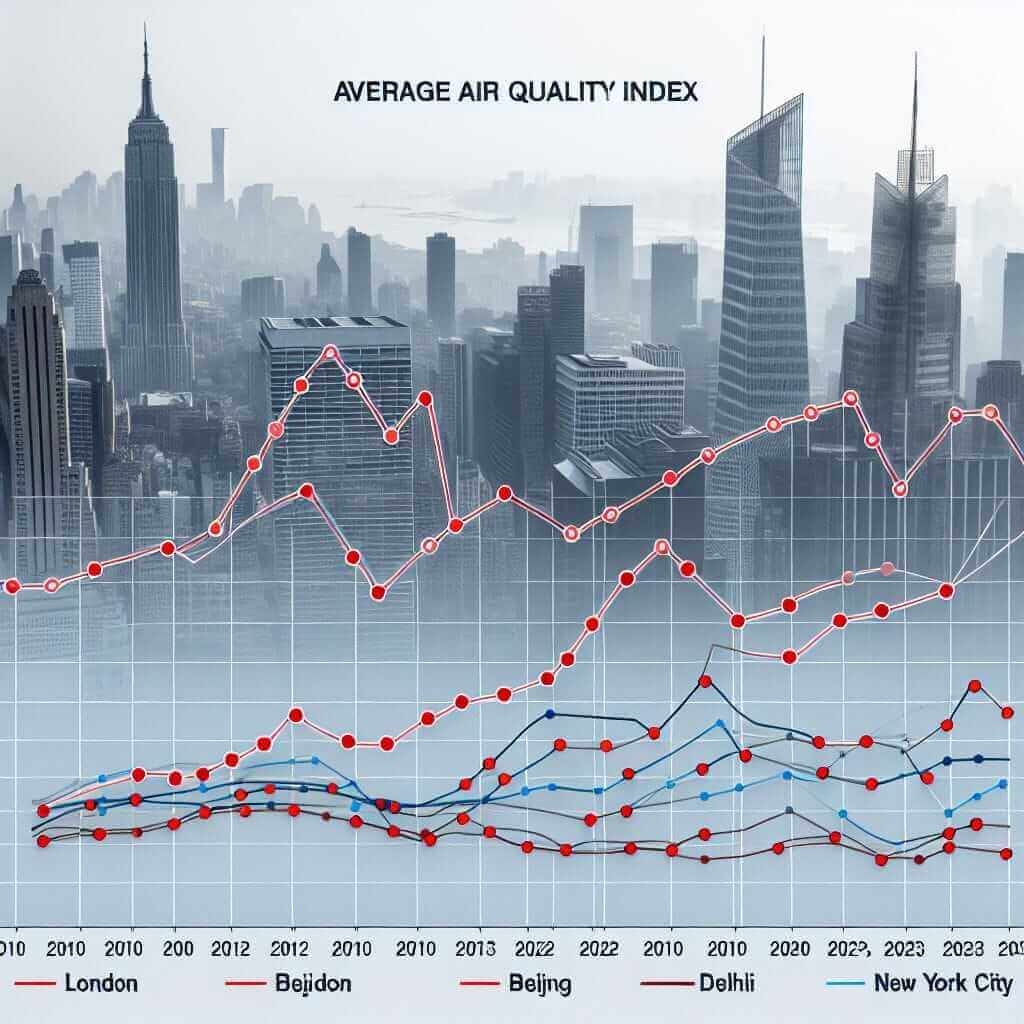The IELTS Writing Task 1 often presents data in various formats, requiring you to analyze and summarize the information effectively. One common theme is environmental issues, with “Air Quality Index in Major Cities” emerging as a frequent topic. This article delves into this subject, equipping you with the necessary skills to achieve a Band 7+ score.
Potential IELTS Writing Task 1 Questions
Based on the keyword “Air Quality Index in Major Cities (2010-2023)”, here are some potential IELTS Writing Task 1 questions:
- The graph below shows the average Air Quality Index (AQI) in four major cities from 2010 to 2023.
- The table illustrates changes in the levels of three pollutants in a major city between 2010 and 2023.
- The chart compares the Air Quality Index (AQI) of two major cities during the summer months from 2010 to 2023.
Sample IELTS Writing Task 1 Question and Model Answer
Let’s select the first question and create a sample answer:
The graph below shows the average Air Quality Index (AQI) in four major cities from 2010 to 2023.
(Insert a line graph here depicting the AQI trends in four cities – London, Beijing, New Delhi, and New York City – from 2010 to 2023. Show some cities improving their AQI over time, while others experience fluctuations or worsening conditions).

Summarize the information by selecting and reporting the main features, and make comparisons where relevant.
Model Answer:
The line graph provides a comparative analysis of the average Air Quality Index (AQI) in four major cities – London, Beijing, New Delhi, and New York City – spanning from 2010 to 2023.
Overall, London and New York City demonstrate a consistent downward trend in AQI, indicating improving air quality. Conversely, Beijing and New Delhi show fluctuating patterns, with the former experiencing a slight improvement in recent years and the latter exhibiting a concerning upward trend, suggesting deteriorating air quality.
In 2010, Beijing had the poorest air quality with an AQI of 90, followed by New Delhi at 80. London and New York City started at a much lower AQI of 50 and 45, respectively. Over the 13-year period, London and New York City have successfully reduced their AQI to approximately 35 and 30, respectively.
Beijing’s AQI fluctuated considerably, reaching a peak of 100 in 2015 before declining to around 70 in 2023. New Delhi, despite some fluctuations, showed a worrying increase in AQI, reaching a concerning level of 95 by 2023.
Word count: 170 words
Key Points for Writing about Air Quality Index:
- Understand the AQI Scale: Familiarize yourself with the AQI scale and what different ranges represent (e.g., Good, Moderate, Unhealthy).
- Trends and Fluctuations: Describe overall trends (increasing, decreasing, fluctuating) and highlight any significant peaks or dips.
- Comparisons: Make clear comparisons between cities, noting any similarities or differences in their AQI trends.
- Data Specificity: Use specific data points from the graph to support your descriptions and comparisons.
- Concise Language: Use clear and concise language to convey the information efficiently.
Useful Vocabulary:
- Air Quality Index (AQI): (n) /ˈeəɹ ˌkwɑːləti ˈɪndɛks/ A measure of how polluted the air is.
- Pollutant: (n) /pəˈluːtənt/ A substance that contaminates air, water, or soil.
- Emission: (n) /iˈmɪʃən/ The discharge of pollutants into the atmosphere.
- Particulate Matter: (n) /pɑːrˈtɪkjʊlət ˈmætər/ Tiny particles of solid or liquid matter in the air.
- Fluctuate: (v) /ˈflʌktʃueɪt/ To rise and fall irregularly.
- Deteriorate: (v) /dɪˈtɪəriəreɪt/ To become worse.
- Concerning: (adj) /kənˈsɜːrnɪŋ/ Causing worry or anxiety.
- Downward Trend: (n) /ˈdaʊnwərd trɛnd/ A general movement towards a lower value or level.
Conclusion:
Mastering the art of writing about data related to the Air Quality Index requires a blend of analytical and linguistic skills. By understanding the nuances of the AQI, utilizing relevant vocabulary, and practicing your writing with sample questions like the one provided, you’ll be well-prepared to achieve a high band score in the IELTS Writing Task 1.